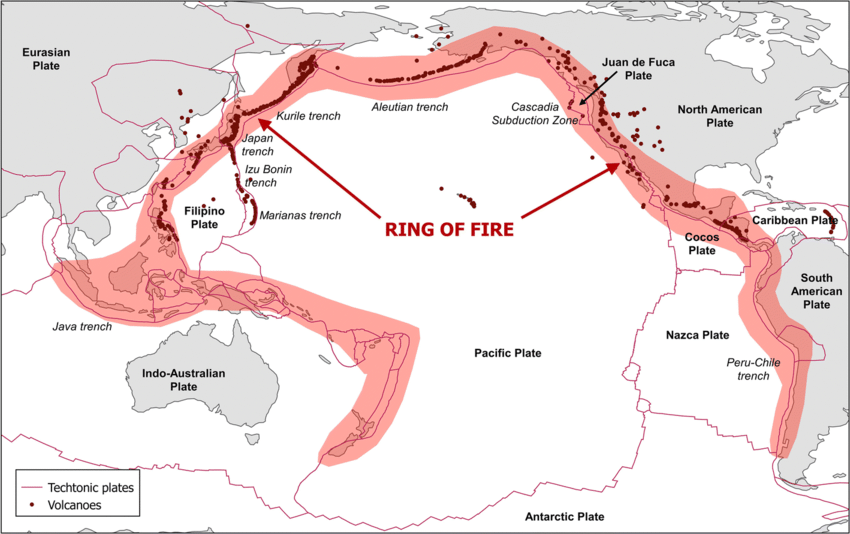Pacific Ring of Fire
The Pacific Ring of Fire, also known as the Circum-Pacific Belt, is a path along the Pacific Ocean characterised by active volcanoes and frequent earthquakes. It is a horseshoe-shaped belt about 40,000 km long and up to about 500 km wide.
Geography
The Pacific Ring of Fire stretches from New Zealand, along the eastern edge of Asia, north across the Aleutian Islands of Alaska, and south along the coast of North and South America. It is composed of over 450 volcanoes, including 75 per cent of the world’s active and dormant volcanoes.
Plate Tectonics
The Ring of Fire is the result of plate tectonics. The eastern section of the ring is the result of the Nazca Plate and the Cocos Plate being subducted beneath the westward-moving South American Plate. The Cocos Plate is being subducted beneath the Caribbean Plate, in Central America. A portion of the Pacific Plate and the small Juan de Fuca Plate are being subducted beneath the North American Plate.
Volcanoes
The Ring of Fire is home to 452 volcanoes, over 75 per cent of the world’s active and dormant volcanoes. Some notable examples include:
- Mount Fuji in Japan
- Mount Pinatubo in the Philippines
- Mount St. Helens in the United States
- Mount Krakatoa in Indonesia
Many of these volcanoes are famous for their violent eruptions and the damage they have caused to nearby populations.
Earthquakes
The Ring of Fire is associated with a nearly continuous series of oceanic trenches, volcanic arcs, and volcanic belts and plate movements. It has 90 per cent of the world’s earthquakes. The motion of the plates and the resulting subduction zones produce about 90 per cent of all earthquakes worldwide, and 80 per cent of the world’s largest earthquakes.
Tsunamis
The Pacific Ring of Fire has experienced some of the most powerful tsunamis in recorded history. One of the most devastating was the 2004 Indian Ocean earthquake and tsunami, which killed over 230,000 people in fourteen countries, and inundated coastal communities with waves up to 30 meters high.
Category: States Current Affairs


